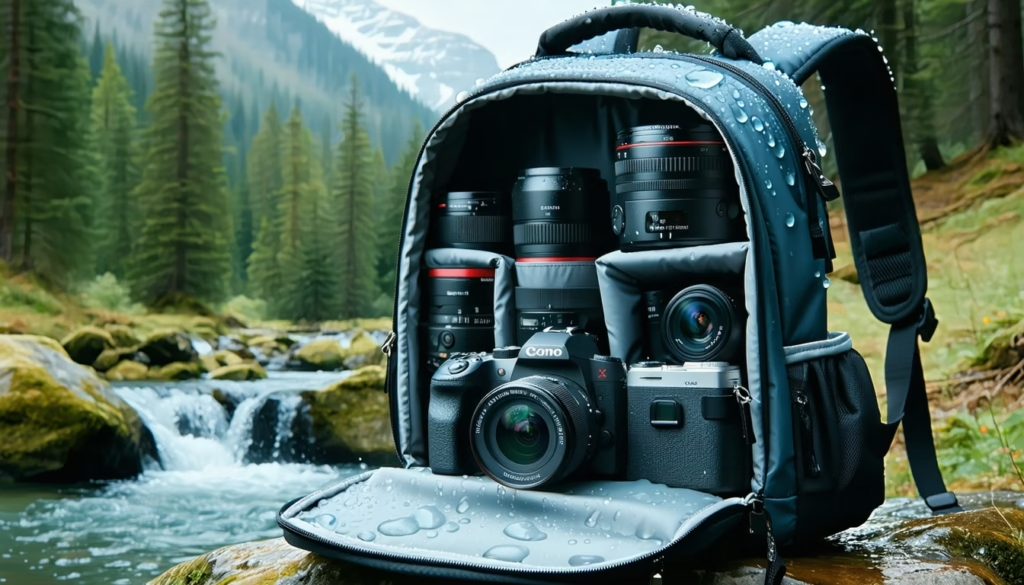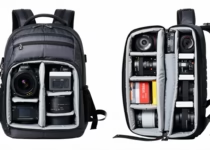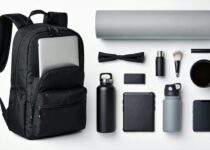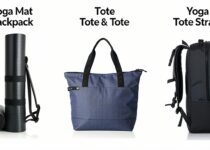What To Look For In A Waterproof Camera Backpack

Chasing rainbows through a thunderstorm sounds poetic, but soggy camera gear is not. If you’re wondering what to look for in a waterproof camera backpack, you’re in the right spot. We’ll cover the must-have features to keep your gear bone-dry and within arm’s reach.
Think of this as your checklist for dry shoots and peace of mind. We’ll cover everything from water resistance ratings to adjustable dividers.
You’ll learn why coated fabrics matter and how to carry a tripod. We’ll also cover which price points deliver the best value.
Ready to dive in? Let’s get started.
Assess Waterproofing Standards
How waterproof is waterproof enough? Start by understanding official water-resistance ratings and sealing techniques.
Understand IPX Ratings
When a backpack carries an IPX7 label, it can handle immersion up to one meter for 30 minutes. Lower ratings, like IPX4, only protect against splashes. Aim for at least IPX6 if you expect heavy rain or river crossings.
Here’s a quick rundown:
| Rating | Protection Level |
|---|---|
| IPX4 | Guard against splashes from any angle |
| IPX5 | Withstand water jets up to 12.5 liters per minute |
| IPX6 | Tolerate more powerful water jets |
| IPX7 | Immersion up to 1 meter for 30 minutes |
| IPX8 | Continuous immersion under specified conditions |
Evaluate Sealed Zippers And Seams
Waterproof zippers use rubberized coatings or protective flaps to keep moisture out. Check that seams are taped or welded rather than stitched, since holes from stitching can let water sneak in. Good sealing means dry gear even when you’re stuck in a downpour.
Examine Material Quality
The choice of fabric can make or break your backpack’s waterproof claim. Look for tough, coated textiles and reinforced stitching.
Ripstop Fabrics And Coatings
Ripstop nylon or polyester with a durable water-repellent (DWR) finish beads water on contact. Higher denier fabrics resist abrasion but add weight. Balance durability and pack weight based on your shooting style.
Reinforced Stitching
Even the best coating fails if seams tear under load. Double-stitched seams with bartack reinforcement at stress points ensure your backpack stays sealed, even when fully loaded. Inspect inside flaps too—they should cover the stitches completely.
Evaluate Size And Capacity
A waterproof shell is useless if you can’t fit your gear comfortably. Match the backpack’s volume to your kit and shooting needs.
Choose The Right Volume
Backpacks range from compact 15-liter models to heavy-duty 45-liter rigs. Small volumes keep weight down for short shoots, while larger packs handle multiple bodies plus accessories. List your essentials and pick a size that provides room without wasted space.
Consider Expandable Sections
Some designs feature expandable compartments or tuck-away rain covers that boost capacity on the fly. This flexibility comes in handy on unpredictable assignments or when you pick up extra gear. Just be sure the expanded section seals properly.
Check Storage Organization
A smart layout keeps your lenses, batteries, and memory cards separate and secure. Look for customizable pockets and dedicated gear slots.
Customizable Dividers
Adjustable dividers let you carve out snug spaces for each piece of equipment. If you want more tips on tailoring your pack, consult our guide on customizing your backpack with inserts. This is where a simple cubby becomes a personalized command center.
Lens And Accessory Pockets
Dedicated lens sleeves guard against scratches and impacts. Bonus pockets for filters, batteries, and chargers stop small items from disappearing into the void. For more on packing your optics, see best ways to organize lenses inside a camera backpack.
Tripod And Drone Gear
Carrying bulky supports shouldn’t turn into a balancing act. Look for reinforced straps or side mounts that keep your tripod snug. If you shoot with a drone, check for pockets that fit your controller and propellers securely. For step-by-step tips, you can read how to carry a tripod using a camera backpack and tips for packing a drone and camera together safely.
Prioritize Comfort Features
You’ll be hauling your backpack for hours, so ease on your shoulders and back is crucial. Seek out ergonomic designs with padding and airflow.
Harness And Straps
Wide, padded shoulder straps distribute weight evenly. A removable sternum strap prevents shoulder fatigue on long hikes. Hip belts take pressure off your shoulders completely by shifting load to your hips. For more ways to prevent back pain when carrying camera gear, check our in-depth guide.
Back Panel Ventilation
Sweat and camera grip don’t mix well. Mesh back panels and ventilation channels promote airflow, keeping your back cooler on hot days. This feature is a game-changer when you’re trekking between locations and need comfort to stay productive.
Test Accessibility Options
Fast access to your camera can be the difference between missing a shot and capturing magic. Make sure you can reach your gear quickly.
Side And Top Access
Side-loading backpacks let you swing the bag around and grab your camera without fully opening it. Top loaders give full access to the main compartment, but can be slower. Test both styles to see which fits your shooting rhythm.
Quick-Release Pockets
Front or hip-belt pockets for memory cards and snacks keep essentials within seconds of reach. Keep your batteries, memory cards, and smartphone in those pockets so you’re not digging through main compartments when time is short.
Review Durability And Warranty
Even high-end bags can fail if they’re poorly built. Factoring in warranty terms gives you peace of mind on your investment.
Stress Points And Reinforcements
Inspect areas that get the most wear—strap anchors, zipper pulls, and base panels. Reinforced stitching and abrasion-resistant feet help those spots hold up under heavy use. A scuff-proof bottom panel can extend a pack’s life significantly.
Warranty Coverage
Backpacks with multi-year warranties show confidence from the maker. Read the fine print to see if water damage is covered and what’s considered “normal wear.” A solid warranty can save you hundreds in replacement costs later.
Compare Price And Value
Waterproof camera backpacks cover a wide price range, so weigh cost against features you actually need.
Budget-Friendly Picks
If you’re starting out, basic waterproofing and modular dividers can cost under $100. These packs are lightweight and functional without breaking the bank. Browse the best budget-friendly camera backpacks for beginners for the top affordable options.
Premium Investments
High-end models may run $200 or more but deliver advanced coatings, custom-fit systems, and rugged frames. If you shoot in extreme conditions or carry pro setups, the extra cost often pays off in longevity and comfort.
FAQs:
How Do I Know a Backpack Is Truly Waterproof?
Check IPX ratings, sealed seams, and rated zippers for proof. Look for third-party tests or reader reviews confirming dry gear after heavy rain.
Can I Use a Rain Cover Instead?
Rain covers add protection, but can slip off or tear. A built-in waterproof shell offers more reliable defense and integrated storage features.
Does Waterproofing Add Much Weight?
Waterproof coatings and coated fabrics do add grams, but modern materials keep weight low. You’ll usually notice just a few extra ounces, well worth the dry gear.
How Often Should I Reapply DWR Coating?
Durable water-repellent finishes fade after roughly 20–30 washes or sprays. When water stops beading on the fabric, it’s time for a fresh DWR application.
Can I Machine Wash My Backpack?
Most waterproof backpacks require hand washing or gentle machine cycles. Always check your manufacturer’s instructions to protect coatings and membranes.
Should I Store My Backpack Wet?
Always air dry your backpack before storing to prevent mold and odors. Store in a cool, dry spot away from direct sunlight.
Conclusion:
Choosing a waterproof camera backpack doesn’t have to feel overwhelming. By checking water-resistance standards, fabric quality, storage layout, comfort features, and warranty, you’ll zero in on the right pack for your shoots.
Now it’s your turn: try out these tips on your next bag search and let us know which feature you value most. Happy shooting and stay dry out there!


